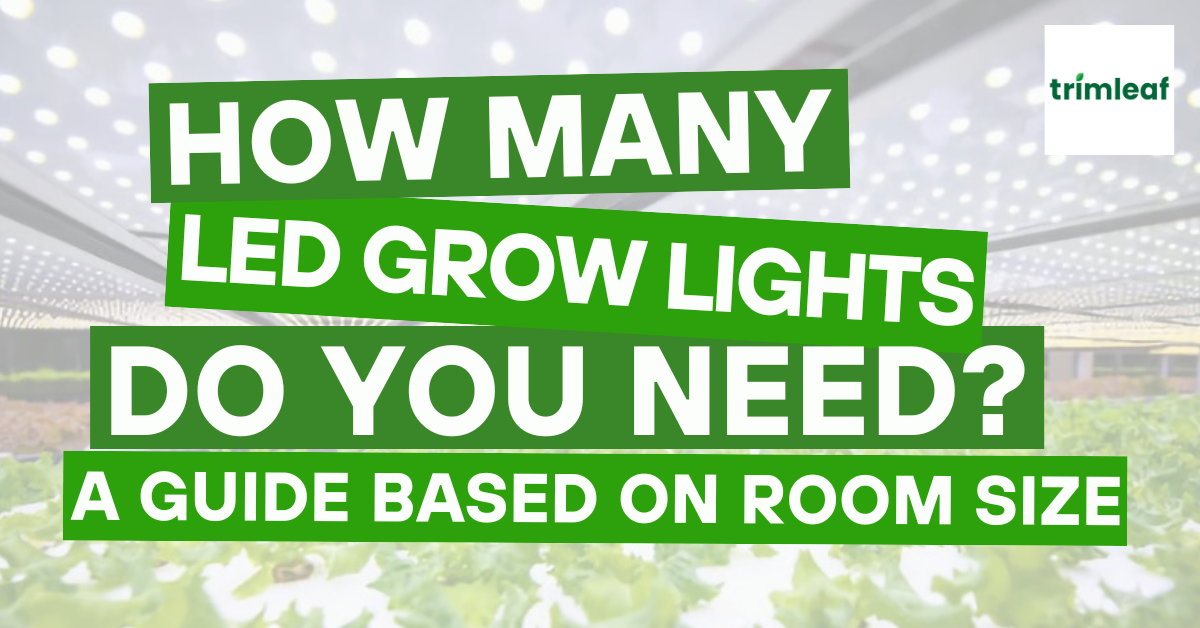
Indoor gardening has become increasingly popular, particularly with the advent of LED grow lights, which provide a reliable and energy-efficient means of cultivating plants year-round.
These lights deliver the specific spectrum of light necessary for photosynthesis, enabling the growth of herbs, vegetables, and flowering plants, regardless of outdoor conditions.
However, one of the biggest challenges in setting up an indoor garden is determining the correct number of LED grow lights needed for your space.
Insufficient lighting can lead to poor plant growth, uneven coverage, and disappointing yields. Conversely, too many lights can result in wasted energy, excessive heat, and unnecessary expenses.
Striking the right balance is essential for optimizing the success and efficiency of your indoor garden. To assist in this, it’s important to understand the factors that determine the number of grow lights you’ll need.
Table of Contents
- Understanding LED Grow Light Basics
- Why LED Grow Lights Are Popular in Indoor Gardening
- Factors Affecting the Number of LED Grow Lights Needed
- Calculating the Number of LED Grow Lights for Different Room Sizes
- Adding Supplementary LED Grow Lights
- Common Mistakes to Avoid and Tips to Optimize Growth
- Conclusion
- Frequently Asked Questions About LED Glow Lights
Understanding LED Grow Light Basics

LED grow lights represent an advancement in artificial lighting, improving upon traditional HPS and HID lights in mimicking sunlight required for photosynthesis. Unlike older lighting options, LED grow lights emit light at specific wavelengths, particularly in the red and blue spectrums, which are highly beneficial for plant growth.
One of the primary advantages of LED grow lights is their efficiency. They consume significantly less electricity compared with other lighting types. This makes them cost-effective and safer to use in indoor environments where temperature management is crucial.
Additionally, LED grow lights have a much longer lifespan, often lasting tens of thousands of hours, reducing the need for frequent replacements and further lowering maintenance costs.
Why LED Grow Lights Are Popular in Indoor Gardening

LED grow lights have become the preferred choice for indoor gardening due to their numerous benefits, such as:
- Energy Efficiency - Making them a sustainable option for long-term use.
- LEDs Produce Less Heat - Reducing the risk of plant damage and allowing lights to be positioned closer to the canopy, which can enhance growth.
- Customizable - Specific light spectrums emitted can be adjusted depending on the plant’s growth stage, leading to more robust plant growth, higher yields, and better overall plant health.
While the initial cost may be higher than other types of lights, the long-term savings in energy and replacement costs make LEDs the most practical choice for serious indoor gardeners.
Factors Affecting the Number of LED Grow Lights Needed
Room Size and Dimensions
Larger rooms naturally require more lights to ensure full coverage and adequate light intensity across the entire space.
Room height is also critical; higher ceilings may necessitate more powerful lights or a greater number of units to maintain optimal light levels at the canopy.
In smaller spaces, fewer lights may be required, but careful placement is essential to avoid creating areas of excessive intensity or shadows that could hinder plant growth.
Plant Type and Light Requirements
Matching your LED grow light setup to the specific needs of your plants ensures healthy growth and maximizes productivity. Leafy greens like lettuce and herbs require less intense light than flowering plants like tomatoes or cannabis.
For plants like succulents that are adapted to high-light environments, more intense lighting will be required compared to shade-loving plants like ferns.
Some plants, particularly those in the flowering or fruiting stages, need more light or a higher-wattage to thrive and produce high yields.
Light Coverage
The effectiveness of your LED grow lights isn’t just about the number of lights but also about the coverage and intensity they provide. This is where understanding PAR (Photosynthetically Active Radiation) becomes important.
PAR refers to the specific range of light wavelengths that plants use for photosynthesis, typically between 400 and 700 nanometers. Ensuring that your lights deliver consistent PAR levels across the entire grow room is essential for uniform plant growth.
Light Intensity
To achieve even light distribution, consider the coverage area of each LED grow light, usually specified by the manufacturer. Overlapping light coverage from multiple LEDs can help prevent dark spots and ensure that every plant receives sufficient light.
Adjusting the height of the lights and their angle can help fine-tune the intensity and spread of light across your grow room, ensuring that all plants receive the necessary light for optimal growth.
LED Wattage
The wattage of your LED grow lights can guide you in understanding how much light you need to illuminate a particular footprint size. As a general rule, aim for 32 watts per square foot of growing space for LED bulbs.
You can combine grow lights to meet the minimum requirement, provided they have the same wattage, and preferably the same grow light model.
Calculating the Number of LED Grow Lights for Different Room Sizes

Small Rooms (up to 6x6 feet)
In smaller grow rooms, fewer grow lights are needed, but ensure that the wattage meets the needs of your plants.
A single LED grow light with a footprint of around 16 or 25 square feet with a wattage between 400 and 600 watts should suffice.
A 6x6 foot room will need a grow light with a footprint of 6x6 feet and a wattage of at least 1000 watts.
Medium Rooms (7-15 feet)
Medium-sized grow rooms require a more strategic approach to ensure even light coverage. In these rooms, you’ll likely need multiple LED grow lights to cover the larger area effectively.
For instance, in a 10x10 foot room, you may use four LED grow lights with a footprint of 5x5 feet each to ensure the entire space is covered without leaving any dark spots.
Large Rooms (more than 15x15 feet)
For large grow rooms of at least 15x15 feet, lighting becomes more complex and requires careful planning and investment. Such wide areas will require a modular setup with multiple LED grow lights strategically placed to cover every part of the room.
For example, in a 20x20 foot room, you might use nine or more LED grow lights, each with a footprint of around 4x4 feet.
Because the design is modular, lights can be added or adjusted as needed, providing flexibility and efficiency in managing light coverage in large grow rooms.
Adding Supplementary LED Grow Lights

Supplementary LED grow lights can be beneficial in both medium and large grow rooms, especially in areas where the primary lights may not provide sufficient coverage or intensity.
For instance, in corners or along the edges of the room, supplementary lights can help ensure that all plants receive adequate light, preventing weak growth in underlit areas.
Supplementary lights are also useful for providing targeted light to specific plants that may require more intensity during certain growth stages.
Common Mistakes to Avoid and Tips to Optimize Growth
Overestimating or Underestimating Light Your Room Needs
Overestimating can lead to wasted energy, excessive heat, and potential light burn on your plants.
Whereas, underestimating can result in poor growth, weak plants, and lower yields.
To avoid these mistakes, always start by assessing the specific light requirements of the plants you’re growing and matching those needs with the appropriate number and intensity of LED grow lights.
Ignoring Light Coverage and Overlap Across Grow Room
A common mistake is failing to consider the overlap of light coverage, which can lead to both underlit and overlit areas.
Without proper overlap, some plants may not receive enough light, while others might be exposed to too much intensity, creating hot spots that can stress or damage your plants.
To avoid this, carefully plan the placement of your LED grow lights to ensure that their coverage areas overlap slightly, providing consistent light levels across the entire growing area.
Conclusion
Understanding how many LED grow lights you need for your grow room is crucial to creating a thriving indoor garden. Properly matching the lights to your room size, plant type, and light coverage needs ensures that your plants receive the optimal amount of light for healthy growth and maximum yields.
For those looking to optimize their indoor gardening experience, we invite you to explore our selection of high-quality LED grow lights on our website. You can also check out our buyer's guide for an overview of popular choices available today.
Read more about LED glow lights here:
- The Best 4x4 LED Grow Lights
- Best LED Grow Lights (2024)
- What You Need to Know About HPS vs. LED Grow Lights
- Growing Indoors with LED Grow Lights? Here are 4 Things to Consider
- Grow Lights: How Many Watts Per Plant/Square Foot is Needed?
- LED Grow Lights and Eye Safety: What You Need to Know
- Pay Attention to These Things When Buying LED Grow Lights
Frequently Asked Questions About LED Glow Lights
- ◄What are the key differences between LED grow lights and traditional lighting options like HPS and HID?
- LED grow lights offer more precise light spectra, energy efficiency, and longer lifespans.
- ◄How do LED grow lights mimic the sunlight required for photosynthesis?
- They emit light at specific wavelengths, especially in the red and blue spectrums, which are essential for plant growth.
- ◄Why are LED grow lights considered more energy-efficient than other lighting options?
- They consume less electricity and produce less heat, reducing energy costs and the need for additional cooling.
- ◄What are the main benefits of using LED grow lights for indoor gardening?
- Energy efficiency, reduced heat production, customizable light spectrums, and longer lifespans.
- ◄Are there any drawbacks or limitations to using LED grow lights?
- The initial cost might be higher than traditional lighting options, but the long-term savings often outweigh this.
- ◄How does room size and dimensions influence the number of LED grow lights required?
- Larger rooms need more lights to ensure full coverage, while smaller rooms may require fewer but more powerful lights.
- ◄What is PAR, and why is it important for indoor gardening?
- PAR is the range of light wavelengths plants use for photosynthesis. Ensuring consistent PAR levels is crucial for optimal growth.
- ◄How does light intensity affect plant growth, and how can I adjust it using LED grow lights?
- Proper light intensity promotes healthy growth and can be adjusted by changing the height and angle of the lights.
- ◄What is the recommended wattage per square foot for indoor gardening using LED grow lights?
- A general rule is 32 watts per square foot.




